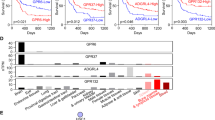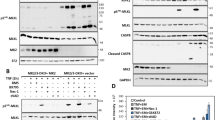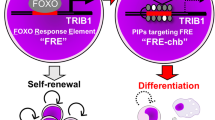Abstract
Tumor necrosis factor-α (TNF-α)-induced RIP1/RIP3 (receptor-interacting protein kinase 1/receptor-interacting protein kinase 3)-mediated necroptosis has been proposed as an alternative strategy for treating apoptosis-resistant leukemia. However, we found that most acute myeloid leukemia (AML) cells, especially M4 and M5 subtypes, produce TNF and show basal level activation of RIP1/RIP3/MLKL signaling, yet do not undergo necroptosis. TNF, through RIP1/RIP3 signaling, prevents degradation of SOCS1, a key negative regulator of interferon-γ (IFN-γ) signaling. Using both pharmacologic and genetic assays, we show here that inactivation of RIP1/RIP3 resulted in reduction of SOCS1 protein levels and partial differentiation of AML cells. AML cells with inactivated RIP1/RIP3 signaling show increased sensitivity to IFN-γ-induced differentiation. RIP1/RIP3 inactivation combined with IFN-γ treatment significantly attenuated the clonogenic capacity of both primary AML cells and AML cell lines. This combination treatment also compromised the leukemogenic ability of murine AML cells in vivo. Our studies suggest that inhibition of RIP1/RIP3-mediated necroptotic signaling might be a novel strategy for the treatment of AML when combined with other differentiation inducers.
This is a preview of subscription content, access via your institution
Access options
Subscribe to this journal
Receive 12 print issues and online access
$259.00 per year
only $21.58 per issue
Buy this article
- Purchase on Springer Link
- Instant access to full article PDF
Prices may be subject to local taxes which are calculated during checkout







Similar content being viewed by others
References
Burnett AK, Hills RK, Milligan DW, Goldstone AH, Prentice AG, McMullin MF et al. Attempts to optimize induction and consolidation treatment in acute myeloid leukemia: results of the MRC AML12 trial. J Clin Oncol 2010; 28: 586–595.
Fernandez HF, Sun Z, Yao X, Litzow MR, Luger SM, Paietta EM et al. Anthracycline dose intensification in acute myeloid leukemia. N Engl J Med 2009; 361: 1249–1259.
Burnett A, Wetzler M, Lowenberg B . Therapeutic advances in acute myeloid leukemia. J Clin Oncol 2011; 29: 487–494.
Pulte D, Gondos A, Brenner H . Expected long-term survival of patients diagnosed with acute myeloblastic leukemia during 2006-2010. Ann Oncol 2010; 21: 335–341.
Chen SJ, Zhou GB, Zhang XW, Mao JH, de The H, Chen Z . From an old remedy to a magic bullet: molecular mechanisms underlying the therapeutic effects of arsenic in fighting leukemia. Blood 2011; 117: 6425–6437.
Lallemand-Breitenbach V, Zhu J, Chen Z, de The H . Curing APL through PML/RARA degradation by As2O3. Trends Mol Med 2012; 18: 36–42.
Chen ZJ . Ubiquitination in signaling to and activation of IKK. Immunol Rev 2012; 246: 95–106.
Sun SC . Non-canonical NF-kappaB signaling pathway. Cell Res 2011; 21: 71–85.
Skaug B, Jiang X, Chen ZJ . The role of ubiquitin in NF-kappaB regulatory pathways. Annu Rev Biochem 2009; 78: 769–796.
Rickard JA, O'Donnell JA, Evans JM, Lalaoui N, Poh AR, Rogers T et al. RIPK1 regulates RIPK3-MLKL-driven systemic inflammation and emergency hematopoiesis. Cell 2014; 157: 1175–1188.
Roderick JE, Hermance N, Zelic M, Simmons MJ, Polykratis A, Pasparakis M et al. Hematopoietic RIPK1 deficiency results in bone marrow failure caused by apoptosis and RIPK3-mediated necroptosis. Proc Natl Acad Sci USA 2014; 111: 14436–14441.
Silke J, Rickard JA, Gerlic M . The diverse role of RIP kinases in necroptosis and inflammation. Nat Immunol 2015; 16: 689–697.
Pasparakis M, Vandenabeele P . Necroptosis and its role in inflammation. Nature 2015; 517: 311–320.
Linkermann A, Green DR . Necroptosis. N Engl J Med 2014; 370: 455–465.
Schimmer AD . Apoptosis in leukemia: from molecular pathways to targeted therapies. Best Pract Res Clin Haematol 2008; 21: 5–11.
Lagadinou ED, Sach A, Callahan K, Rossi RM, Neering SJ, Minhajuddin M et al. BCL-2 inhibition targets oxidative phosphorylation and selectively eradicates quiescent human leukemia stem cells. Cell Stem Cell 2013; 12: 329–341.
Goff DJ, Court Recart A, Sadarangani A, Chun HJ, Barrett CL, Krajewska M et al. A Pan-BCL2 inhibitor renders bone-marrow-resident human leukemia stem cells sensitive to tyrosine kinase inhibition. Cell Stem Cell 2013; 12: 316–328.
Su Z, Yang Z, Xie L, DeWitt JP, Chen Y . Cancer therapy in the necroptosis era. Cell Death Differ 2016; 23: 748–756.
Zhou W, Yuan J . Necroptosis in health and diseases. Semin Cell Dev Biol 2014; 35: 14–23.
Fulda S . The mechanism of necroptosis in normal and cancer cells. Cancer Biol Ther 2013; 14: 999–1004.
Newton K, Sun X, Dixit VM . Kinase RIP3 is dispensable for normal NF-kappa Bs, signaling by the B-cell and T-cell receptors, tumor necrosis factor receptor 1, and Toll-like receptors 2 and 4. Mol Cell Biol 2004; 24: 1464–1469.
Jiang X, Bugno J, Hu C, Yang Y, Herold T, Qi J et al. Eradication of acute myeloid leukemia with FLT3 ligand-targeted miR-150 nanoparticles. Cancer Res 2016; 76: 4470–4480.
Weisberg E, Ray A, Barrett R, Nelson E, Christie AL, Porter D et al. Smac mimetics: implications for enhancement of targeted therapies in leukemia. Leukemia 2010; 24: 2100–2109.
Servida F, Lecis D, Scavullo C, Drago C, Seneci P, Carlo-Stella C et al. Novel second mitochondria-derived activator of caspases (Smac) mimetic compounds sensitize human leukemic cell lines to conventional chemotherapeutic drug-induced and death receptor-mediated apoptosis. Invest New Drugs 2011; 29: 1264–1275.
Steinhart L, Belz K, Fulda S . Smac mimetic and demethylating agents synergistically trigger cell death in acute myeloid leukemia cells and overcome apoptosis resistance by inducing necroptosis. Cell Death Dis 2013; 4: e802.
Fulda S, Vucic D . Targeting IAP proteins for therapeutic intervention in cancer. Nat Rev Drug Discov 2012; 11: 109–124.
Volk A, Li J, Xin J, You D, Zhang J, Liu X et al. Co-inhibition of NF-kappaB and JNK is synergistic in TNF-expressing human AML. J Exp Med 2014; 211: 1093–1108.
Degterev A, Huang Z, Boyce M, Li Y, Jagtap P, Mizushima N et al. Chemical inhibitor of nonapoptotic cell death with therapeutic potential for ischemic brain injury. Nat Chem Biol 2005; 1: 112–119.
Degterev A, Maki JL, Yuan J . Activity and specificity of necrostatin-1, small-molecule inhibitor of RIP1 kinase. Cell Death Differ 2013; 20: 366.
Xiao Y, Li H, Zhang J, Volk A, Zhang S, Wei W et al. TNF-alpha/Fas-RIP-1-induced cell death signaling separates murine hematopoietic stem cells/progenitors into 2 distinct populations. Blood 2011; 118: 6057–6067.
Cho YS, Challa S, Moquin D, Genga R, Ray TD, Guildford M et al. Phosphorylation-driven assembly of the RIP1-RIP3 complex regulates programmed necrosis and virus-induced inflammation. Cell 2009; 137: 1112–1123.
Ball ED, Guyre PM, Shen L, Glynn JM, Maliszewski CR, Baker PE et al. Gamma interferon induces monocytoid differentiation in the HL-60 cell line. J Clin Invest 1984; 73: 1072–1077.
Xiao S, Li D, Zhu HQ, Song MG, Pan XR, Jia PM et al. RIG-G as a key mediator of the antiproliferative activity of interferon-related pathways through enhancing p21 and p27 proteins. Proc Natl Acad Sci USA 2006; 103: 16448–16453.
Mi JQ, Li JM, Shen ZX, Chen SJ, Chen Z . How to manage acute promyelocytic leukemia. Leukemia 2012; 26: 1743–1751.
Zhang J, Seet CS, Sun C, Li J, You D, Volk A et al. p27 maintains a subset of leukemia stem cells in the quiescent state in murine MLL-leukemia. Mol Oncol 2013; 7: 1069–1082.
McComb S, Cessford E, Alturki NA, Joseph J, Shutinoski B, Startek JB et al. Type-I interferon signaling through ISGF3 complex is required for sustained Rip3 activation and necroptosis in macrophages. Proc Natl Acad Sci USA 2014; 111: E3206–E3213.
Dillon CP, Weinlich R, Rodriguez DA, Cripps JG, Quarato G, Gurung P et al. RIPK1 blocks early postnatal lethality mediated by caspase-8 and RIPK3. Cell 2014; 157: 1189–1202.
Chen DJ, Huerta S . Smac mimetics as new cancer therapeutics. Anticancer Drugs 2009; 20: 646–658.
Bai L, Smith DC, Wang S . Small-molecule SMAC mimetics as new cancer therapeutics. Pharmacol Ther 2014; 144: 82–95.
Fulda S . Inhibitor of Apoptosis (IAP) proteins in hematological malignancies: molecular mechanisms and therapeutic opportunities. Leukemia 2014; 28: 1414–1422.
Dean E, Jodrell D, Connolly K, Danson S, Jolivet J, Durkin J et al. Phase I trial of AEG35156 administered as a 7-day and 3-day continuous intravenous infusion in patients with advanced refractory cancer. J Clin Oncol 2009; 27: 1660–1666.
Schimmer AD, Estey EH, Borthakur G, Carter BZ, Schiller GJ, Tallman MS et al. Phase I/II trial of AEG35156 X-linked inhibitor of apoptosis protein antisense oligonucleotide combined with idarubicin and cytarabine in patients with relapsed or primary refractory acute myeloid leukemia. J Clin Oncol 2009; 27: 4741–4746.
Carter BZ, Mak DH, Morris SJ, Borthakur G, Estey E, Byrd AL et al. XIAP antisense oligonucleotide (AEG35156) achieves target knockdown and induces apoptosis preferentially in CD34+38- cells in a phase 1/2 study of patients with relapsed/refractory AML. Apoptosis 2011; 16: 67–74.
Pichler M, Hutterer GC, Chromecki TF, Jesche J, Kampel-Kettner K, Rehak P et al. Histologic tumor necrosis is an independent prognostic indicator for clear cell and papillary renal cell carcinoma. Am J Clin Pathol 2012; 137: 283–289.
You D, Xin J, Volk A, Wei W, Schmidt R, Scurti G et al. FAK mediates a compensatory survival signal parallel to PI3K-AKT in PTEN-null T-ALL cells. Cell Rep 2015; 10: 2055–2068.
Gallagher KK, Spector ME, Pepper JP, McKean EL, Marentette LJ, McHugh JB . Esthesioneuroblastoma: updating histologic grading as it relates to prognosis. Annals Otol Rhinol Laryngol 2014; 123: 353–358.
Balkwill F . Tumour necrosis factor and cancer. Nat Rev Cancer 2009; 9: 361–371.
Mantovani A, Allavena P, Sica A, Balkwill F . Cancer-related inflammation. Nature 2008; 454: 436–444.
Hockendorf U, Yabal M, Herold T, Munkhbaatar E, Rott S, Jilg S et al. RIPK3 restricts myeloid leukemogenesis by promoting cell death and differentiation of leukemia initiating cells. Cancer Cell 2016; 30: 75–91.
Vanlangenakker N, Vanden Berghe T, Vandenabeele P . Many stimuli pull the necrotic trigger, an overview. Cell Death Differ 2012; 19: 75–86.
Takahashi N, Duprez L, Grootjans S, Cauwels A, Nerinckx W, DuHadaway JB et al. Necrostatin-1 analogues: critical issues on the specificity, activity and in vivo use in experimental disease models. Cell Death Dis 2012; 3: e437.
Takahashi N, Vereecke L, Bertrand MJ, Duprez L, Berger SB, Divert T et al. RIPK1 ensures intestinal homeostasis by protecting the epithelium against apoptosis. Nature 2014; 513: 95–99.
Dannappel M, Vlantis K, Kumari S, Polykratis A, Kim C, Wachsmuth L et al. RIPK1 maintains epithelial homeostasis by inhibiting apoptosis and necroptosis. Nature 2014; 513: 90–94.
Kaiser WJ, Sridharan H, Huang C, Mandal P, Upton JW, Gough PJ et al. Toll-like receptor 3-mediated necrosis via TRIF, RIP3, and MLKL. J Biol Chem 2013; 288: 31268–31279.
Newton K, Dugger DL, Wickliffe KE, Kapoor N, de Almagro MC, Vucic D et al. Activity of protein kinase RIPK3 determines whether cells die by necroptosis or apoptosis. Science 2014; 343: 1357–1360.
Mandal P, Berger SB, Pillay S, Moriwaki K, Huang C, Guo H et al. RIP3 induces apoptosis independent of pronecrotic kinase activity. Mol Cell 2014; 56: 481–495.
Acknowledgements
We thank the staff of the Department of Comparative Medicine of Loyola University Medical Center for animal care services, as well as Drs Manuel Diaz, Nancy Zeleznik-Le, Andrew Dingwall and Wei Qiu for their ongoing professional collaboration and scientific suggestions and discussions that have improved the present studies. We also thank the members of Dr Wei Qiu’s and Dr Stephanie Watkins’s laboratories for imaging assistance. We appreciate laboratory support from Patience Oladeinde, Danielle Howard and Emma Yao, and FACS sorting and analysis assistance from Patricia Simms, Ashley Hess, Shwetha Ravichandran and Veronica Volgina. This work was supported by NIH (Grants R01-HL095896 and R21-CA181970 to JZ through Loyola University Chicago) and the Leukemia Research Foundation New Investigator Award (8th Annual George Richard Memorial Grant to JX). JX was also supported in part by a grant from the Muscular Dystrophy Association (MDA202906). AV was supported by NRSA F31 Fellowship (F31CA17417). JL and Jun Z were supported by National Basic Research Program of China (Project 2013CB966800), the Program for Basic Research of Shanghai Municipal Science and Technology Commission (Grant No. 13JC1406403).
Author contributions
JX designed the experiments, analyzed the data and drafted the manuscript; Jiwang Z supervised the overall research, designed the experiments, analyzed the data and edited the manuscript; JX, JL, Jun Z, RS, DY, AV, AN, GN, RG, JC, JP, WW, ZX, YC, PB, HC, Jiang Z and Jianke Z collectively contributed to data collection and interpretation of the results; JC provided microarray data; MMP, PCK, SN and AK provided study samples, clinical data, helped to write and revised the manuscript. PB helped to write, and also edited and refined the manuscript.
Author information
Authors and Affiliations
Corresponding authors
Ethics declarations
Competing interests
The authors declare no conflict of interest.
Additional information
Supplementary Information accompanies this paper on the Leukemia website
Supplementary information
Rights and permissions
About this article
Cite this article
Xin, J., You, D., Breslin, P. et al. Sensitizing acute myeloid leukemia cells to induced differentiation by inhibiting the RIP1/RIP3 pathway. Leukemia 31, 1154–1165 (2017). https://doi.org/10.1038/leu.2016.287
Received:
Revised:
Accepted:
Published:
Issue Date:
DOI: https://doi.org/10.1038/leu.2016.287
This article is cited by
-
MLKL in cancer: more than a necroptosis regulator
Cell Death & Differentiation (2021)
-
RIPK3 signaling and its role in the pathogenesis of cancers
Cellular and Molecular Life Sciences (2021)
-
RIP kinases as modulators of inflammation and immunity
Nature Immunology (2018)



